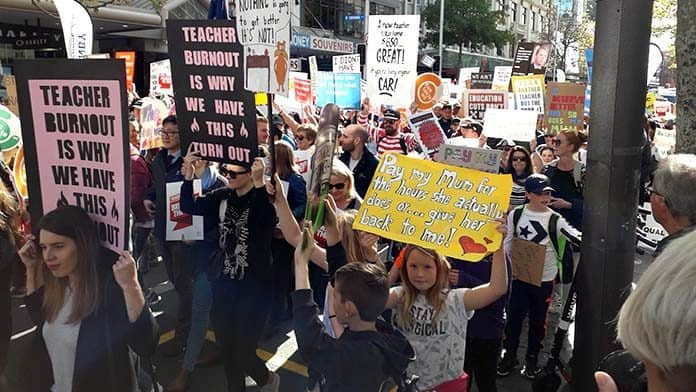Aotearoa/New Zealand’s largest ever nationwide education “mega-strike” took place on Wednesday 29 May. There was a mood of determination, enthusiasm and strong solidarity shown with the participation of teachers, principals, parents, students and the public.
It was the first time that the two teacher unions have coordinated strike action across the entire compulsory schooling sector. The strike involved approximately 50,000 teachers—and three quarters of a million children stayed away from state and state-integrated, “special character” often religious, schools. For primary teachers this is the third day of strike action since their collective agreement expired on 8 June 2018.
Tens of thousands of teachers, principals, parents and members of the wider community participated in nationwide public protests. In Auckland the march was 15,000-strong, taking over 20 minutes for all the marchers to pass the start point.
The strike was very widely supported by parents and the public. Many attended the protests while others assisted with childcare for parents who had to go to work. This included some employers allowing workers’ children to be taken to work for the day.
This mega-strike was the result of the current Labour, New Zealand First and Green Party Government refusing to negotiate effective solutions to the real and growing crisis in NZ education. This crisis is the result of 35 years of neo-liberal governments deliberately underfunding education whilst attacking effective teaching practices and structuring education on a business model where schools are left to compete against each other for students and inadequate funds.
Teacher unionists have steadfastly resisted these changes. They have defended the right of every child to attend an excellent school, and to meet their full potential.
Now, after nine years of intensive attacks on the public service by National Government, teachers, as government workers, have high expectations of the Labour Coalition government.
The teacher unions have been trying to negotiate pay, teaching and learning conditions that will attract and retain teachers, reduce workloads and provide additional skilled staff for the growing number of children with additional needs.
Teachers are demanding that the government fund education so that every child, including those with additional needs, receives the personal attention they need to learn and thrive.
Prior to the strike Linda Stuart, president of NZEI Te Riu Roa, the union representing primary school teachers, said that, “The outcome shows teachers and principals are united and resolute in their commitment to getting significantly improved pay, time and support for learning needs.”
Jack Boyle, President of the Post Primary Teachers Association (PPTA) stated that, “We want to work with the government to find solutions that make teaching the attractive career it should be.” He added that, “A well-resourced, equitable education system is essential for a healthy society. We hope the government acts on its principles and makes that happen.”
Government back-flip
The PPTA planned continuing nationwide industrial action each week beginning with “rostered-home” year levels, where teachers refuse to teach one year level for a day. This started on Tuesday 4 June. “Rolling Regional Strikes” for a full day across each region were set to follow.
Before the strike the Minister of Education, Chris Hipkins insisted, “there’s not going to be any more money”. But two weeks later he back-flipped, offering an extra $271 million to boost teacher pay. Teacher base rates will now increase by around 3 per cent a year on average, and current teachers have been promised a total pay increase of at least 18.5 per cent over three years taking into account progression to higher pay scales.
Pay parity between primary and secondary school teachers will also be restored.
However the deal does not address teacher demands over reducing workload through more classroom release time and extra learning support staff. The Education Ministry has signed a separate accord with the teaching unions with an undertaking to investigate further measures on these issues.
Both teacher unions have recommended that members accept the deal, with teachers set to vote by 25 June.
Teachers have not won everything they wanted. But the result shows that strike action works to force gains on pay and conditions.
The teachers’ strike was the latest in the strike wave in New Zealand since the election of Jacinda Ardern’s Labour lead Coalition Government, with nurses, public servants, junior doctors, bus drivers and fast food workers all taking action after years of intimidation.
The fight for a better education system will continue. But the teachers’ campaign is a lesson for other workers about how to win.
By Anna Lee
Retired member, NZEI Te Riu Roa






